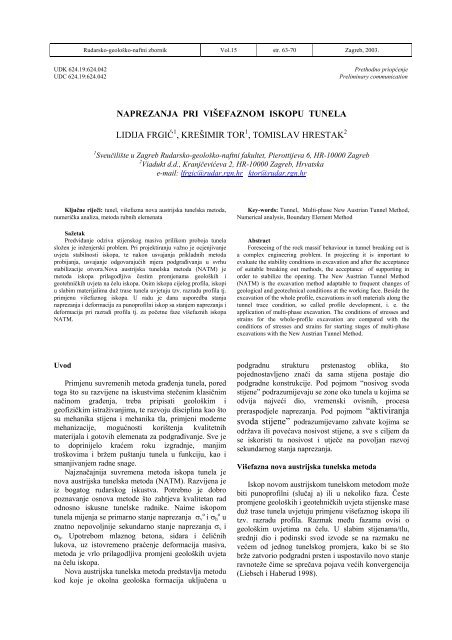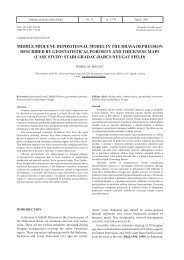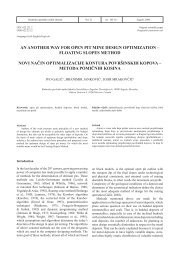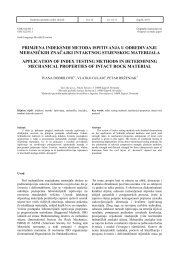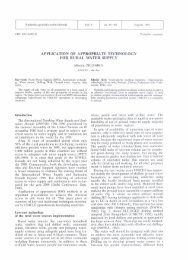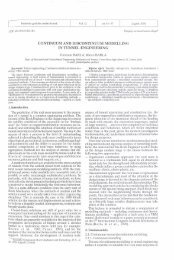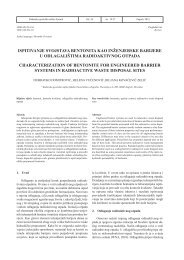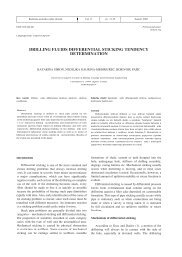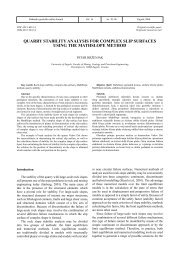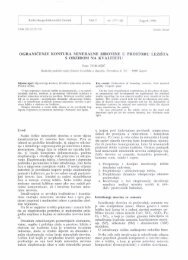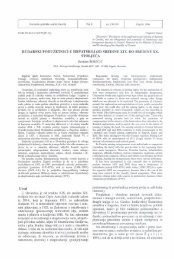pdf (637 KB)
pdf (637 KB)
pdf (637 KB)
Create successful ePaper yourself
Turn your PDF publications into a flip-book with our unique Google optimized e-Paper software.
Rudarsko-geološko-naftni zbornik Vol.15 str. 63-70 Zagreb, 2003.<br />
UDK 624.19:624.042<br />
UDC 624.19:624.042<br />
Prethodno priopćenje<br />
Preliminary communication<br />
NAPREZANJA PRI VIŠEFAZNOM ISKOPU TUNELA<br />
LIDIJA FRGIĆ 1 , KREŠIMIR TOR 1 , TOMISLAV HRESTAK 2<br />
1 Sveučilište u Zagreb Rudarsko-geološko-naftni fakultet, Pierottijeva 6, HR-10000 Zagreb<br />
2 Viadukt d.d., Kranjčevićeva 2, HR-10000 Zagreb, Hrvatska<br />
e-mail: lfrgic@rudar.rgn.hr ktor@rudar.rgn.hr<br />
Ključne riječi: tunel, višefazna nova austrijska tunelska metoda,<br />
numerička analiza, metoda rubnih elemenata<br />
Sažetak<br />
Predviđanje odziva stijenskog masiva prilikom proboja tunela<br />
složen je inženjerski problem. Pri projektiranju važno je ocjenjivanje<br />
uvjeta stabilnosti iskopa, te nakon usvajanja prikladnih metoda<br />
probijanja, usvajanje odgovarajućih mjera podgrađivanja u svrhu<br />
stabilizacije otvora.Nova austrijska tunelska metoda (NATM) je<br />
metoda iskopa prilagodljiva čestim promjenama geoloških i<br />
geotehničkih uvjeta na čelu iskopa. Osim iskopa cijelog profila, iskopi<br />
u slabim materijalima duž trase tunela uvjetuju tzv. razradu profila tj.<br />
primjenu višefaznog iskopa. U radu je dana usporedba stanja<br />
naprezanja i deformacija za punoprofilni iskop sa stanjem naprezanja i<br />
deformacija pri razradi profila tj. za početne faze višefaznih iskopa<br />
NATM.<br />
Key-words: Tunnel, Multi-phase New Austrian Tunnel Method,<br />
Numerical analysis, Boundary Element Method<br />
Abstract<br />
Foreseeing of the rock massif behaviour in tunnel breaking out is<br />
a complex engineering problem. In projecting it is important to<br />
evaluate the stability conditions in excavation and after the acceptance<br />
of suitable breaking out methods, the acceptance of supporting in<br />
order to stabilize the opening. The New Austrian Tunnel Method<br />
(NATM) is the excavation method adaptable to frequent changes of<br />
geological and geotechnical conditions at the working face. Beside the<br />
excavation of the whole profile, excavations in soft materials along the<br />
tunnel trace condition, so called profile development, i. e. the<br />
application of multi-phase excavation. The conditions of stresses and<br />
strains for the whole-profile excavation are compared with the<br />
conditions of stresses and strains for starting stages of multi-phase<br />
excavations with the New Austrian Tunnel Method.<br />
Uvod<br />
Primjenu suvremenih metoda građenja tunela, pored<br />
toga što su razvijene na iskustvima stečenim klasičnim<br />
načinom građenja, treba pripisati geološkim i<br />
geofizičkim istraživanjima, te razvoju disciplina kao što<br />
su mehanika stijena i mehanika tla, primjeni moderne<br />
mehanizacije, mogućnosti korištenja kvalitetnih<br />
materijala i gotovih elemenata za podgrađivanje. Sve je<br />
to doprinijelo kraćem roku izgradnje, manjim<br />
troškovima i bržem puštanju tunela u funkciju, kao i<br />
smanjivanjem radne snage.<br />
Najznačajnija suvremena metoda iskopa tunela je<br />
nova austrijska tunelska metoda (NATM). Razvijena je<br />
iz bogatog rudarskog iskustva. Potrebno je dobro<br />
poznavanje osnova metode što zahtjeva kvalitetan rad<br />
odnosno iskusne tunelske radnike. Naime iskopom<br />
tunela mijenja se primarno stanje naprezanja σ v o i σ h o u<br />
znatno nepovoljnije sekundarno stanje naprezanja σ v i<br />
σ h . Upotrebom mlaznog betona, sidara i čeličnih<br />
lukova, uz istovremeno praćenje deformacija masiva,<br />
metoda je vrlo prilagodljiva promjeni geoloških uvjeta<br />
na čelu iskopa.<br />
Nova austrijska tunelska metoda predstavlja metodu<br />
kod koje je okolna geološka formacija uključena u<br />
podgradnu strukturu prstenastog oblika, što<br />
pojednostavljeno znači da sama stijena postaje dio<br />
podgradne konstrukcije. Pod pojmom “nosivog svoda<br />
stijene” podrazumijevaju se zone oko tunela u kojima se<br />
odvija najveći dio, vremenski ovisnih, procesa<br />
preraspodjele naprezanja. Pod pojmom “aktiviranja<br />
svoda stijene” podrazumijevamo zahvate kojima se<br />
održava ili povećava nosivost stijene, a sve s ciljem da<br />
se iskoristi tu nosivost i utječe na povoljan razvoj<br />
sekundarnog stanja naprezanja.<br />
Višefazna nova austrijska tunelska metoda<br />
Iskop novom austrijskom tunelskom metodom može<br />
biti punoprofilni (slučaj a) ili u nekoliko faza. Česte<br />
promjene geoloških i geotehničkih uvjeta stijenske mase<br />
duž trase tunela uvjetuju primjenu višefaznog iskopa ili<br />
tzv. razradu profila. Razmak među fazama ovisi o<br />
geološkim uvjetima na čelu. U slabim stijenama/tlu,<br />
srednji dio i podinski svod izvode se na razmaku ne<br />
većem od jednog tunelskog promjera, kako bi se što<br />
brže zatvorio podgradni prsten i uspostavilo novo stanje<br />
ravnoteže čime se sprečava pojava većih konvergencija<br />
(Liebsch i Haberud 1998).
Rud.-geol..-naft. zb., Vol. 15, 2003.<br />
64 L. Frgić, K. Tor, T. Hrestak: Naprezanja pri višefaznom iskopu tunela<br />
Dva najčešće primjenjivana načina višefaznog<br />
iskopa su:<br />
• iskop u tri faze: I. kalota – II. srednji dio –<br />
III. podinski svod (slika 1) i<br />
• iskop bočnim potkopima (iskop u pet faza):<br />
I. bočni potkop I – II. bočni potkop II – III.<br />
kalota – IV. srednji dio – V. podinski svod<br />
(slika 2).<br />
Kod tunela većih poprečnih presjeka bočni potkopi<br />
se mogu izvoditi i u dvije faze s privremenim<br />
podnožnim svodom od mlaznog betona unutar potkopa<br />
(Sauer, 1994).<br />
Slika 1. Višefazni iskop NATM u tri faze (slučaj b)<br />
Figure 1. The multi-phase excavations NATM in three phases (case b)<br />
Proračun stanja naprezanja<br />
Proračun stanja naprezanja i deformacija kod<br />
punoprofilnog i višefaznog iskopa tunelskog profila<br />
provodimo numeričkim metodama. Metoda rubnih<br />
elemenata MRE (Boundary Element Method - BEM)<br />
je numerička metoda, koja se primjenjuje u geotehnici<br />
za rješavanje raspodjele naprezanja i deformacija u<br />
stijenskom masivu gdje prilikom nekog zahvata dolazi<br />
do promjene stanja naprezanja. Metoda omogućava<br />
uštedu vremena pri zadavanju tj. definiranju problema u<br />
procesu projektiranja, fleksibilnost u zadavanju ulaznih<br />
parametara koji karakteriziraju masiv i uočavanje<br />
utjecaja njihovih promjena na stanje naprezanja i<br />
deformacija. Ona nadopunjava postojeće numeričke<br />
metode – metodu konačnih razlika MKR (Finite<br />
Diference Method - FDM) i metodu konačnih<br />
elemenata MKE (Finite Element Method - FEM).<br />
Teoretske postavke i dokazi metode rubnih elemenata<br />
opširno su dani u članku Hudec i Frgić (1993), pa se<br />
ovdje neće posebno objašnjavati. Softver rubnih<br />
elemenata (Brebia, 1992 i Brebia & Dominguez, 1992)<br />
nadograđen je utjecajem primarne podgrade od mlaznog<br />
betona na proračun stanja naprezanja i deformacija uz<br />
otvore, predprocesorom za interaktivno zadavanje<br />
ulaznih podataka i postprocesorom za grafički prikaz<br />
rezultata.<br />
Stanje naprezanja u okolini podzemnog otvora ovisi<br />
o opterećenju masiva silama vlastite težine i direktnog<br />
opterećenja ruba otvora silama koje nastaju uslijed<br />
djelovanja podgradnog sustava. Vertikalna i<br />
horizontalna naprezanja ovisna su o dubini ispod<br />
površine terena<br />
σ ° v = ρ×g×h (kN/m 2 ) (1)<br />
σ ° °<br />
h = k × σ v (kN/m 2 ) (2)<br />
pri čemu je:<br />
ρ - gustoća stijene ( t/m 3 ),<br />
g - ubrzanje sile teže – 9,81 m/s 2 ),<br />
h - dubina ispod površine terena m),<br />
k - odnos horizontalnog i vertikalnog<br />
naprezanja.<br />
Uvjeti loma definirani su Hoek-Brownovim kriterijem<br />
σ = σ + mσ<br />
σ + sσ<br />
(3)<br />
2<br />
1 3<br />
c 3 c<br />
Slika 2. Iskop bočnim potkopima - višefazni iskop u pet faza (slučaj<br />
c)<br />
Figure 2. The multi-phase excavation with sidewall drift – The<br />
excavations in five phases (case c)<br />
pri čemu su:<br />
σ<br />
1<br />
i σ<br />
3<br />
- glavna tlačna naprezanja (najveće i<br />
najmanje),<br />
m i s - konstante koje definiraju odnose<br />
čvrstoće masiva i uzorka stijene<br />
- jednoosna tlačna čvrstoća uzorka<br />
stijene.<br />
σ<br />
c
Rud.-geol..-naft. zb., Vol. 15, 2003.<br />
L. Frgić, K. Tor, T. Hrestak: Naprezanja pri višefaznom iskopu tunela 65<br />
Mreže rubnih elemenata za punoprofilni iskop<br />
(slučaj a) i iskop I. faze – kalote (slučaj b) i bočnim<br />
potkopima II. faza (slučaj c II ) prikazane su na slikama 3<br />
i 4. Korištenjem osi simetrije y, za proračun stanja<br />
naprezanja kod punoprofilnog iskopa zadaju se<br />
geometrijski podaci za samo jednu polovinu presjeka<br />
(sl. 3).<br />
Punoprofilni iskop (slučaj a) Iskop I. faze – kalote (slučaj b)<br />
Whole profile excavation (case a) Exavation 1 st stage - crown (case b)<br />
Slika 3. Mreža rubnih elemenata<br />
Figure 3. Mesh of boundary elements<br />
Uz pretpostavku da je materijal stijene<br />
razlomljeni pješčenjak, usvojen je geološki indeks<br />
čvrstoće GSI = 30, stijena blokovita/poremećena,<br />
naborana ili rasjedana s oštrokutnim blokovima, s<br />
mnogo sustava diskontinuiteta i lošim stanjem ploha<br />
diskontinuiteta – klizave jako rastrošene kompaktne<br />
prevlake i ispune uglatim ulomcima. U proračunu su<br />
usvojene slijedeće vrijednosti:<br />
Slika 4. Iskop bočnim potkopima prva faza (slučaj c I ) – mreža rubnih<br />
elemenata<br />
.<br />
Figure 4. Exavation with sidewall drift 1 st stage (case c I ) – Mesh of<br />
boundary elements<br />
jednoosna čvrstoća<br />
σ = 70 000 kN/m 2<br />
konstante stijenskog masiva m = 1,23 i<br />
s = 0,04<br />
modul elastičnosti E = 5 000 MN/m 2<br />
Poissonov koeficijent ν = 0,30<br />
gustoća ρ = 2, 40 t/m 3<br />
odnos k = σ ° °<br />
h /σ v k = ν/(1−ν) = 0,43<br />
visina nadsloja h = 100 m.<br />
Zbog koncentracije naprezanja po rubu otvora, za<br />
ocjenu uvjeta stabilnosti pri iskopu, uspoređena su<br />
tangencijalna (cirkularna) naprezanja σ 1 po konturi.<br />
c
Rud.-geol..-naft. zb., Vol. 15, 2003.<br />
66 L. Frgić, K. Tor, T. Hrestak: Naprezanja pri višefaznom iskopu tunela<br />
Kod iskopa u tri faze, I. faze - kalota, zajednički<br />
elementi s punoprofilnim iskopom su elementi kalote<br />
11–17, dok su pri bočnim iskopima, I. i II. faze elementi<br />
4 – 11 istovjetni elementima bokova 6 – 13<br />
punoprofilnog iskopa. Ispis rezultata proračuna dobiva<br />
se u središnjim točkama rubnih elemenata i u<br />
generiranim točkama masiva.<br />
Proračun stanja naprezanja i deformacija je proveden<br />
za:<br />
• slučaj a: iskop cijelog profila<br />
• slučaj b: I. faze iskopa u tri faze<br />
• slučaj c: I. faze iskopa bočnim potkopima c I.<br />
i II. faze iskopa bočnim potkopima c II.<br />
• slučaj d: punoprofilni iskop podgrađen mlaznim<br />
betonom.<br />
Uz navedene slučajeve iskopa a), b) i c), a radi<br />
usporedbe, proračunato je i stanje naprezanja<br />
punoprofilnog iskopa podgrađenog slojem mlaznog<br />
betona (slučaj d), jer presudan utjecaj na stanje<br />
naprezanja i deformacija, uz otvore tunela, osim načina<br />
iskopa ima primijenjeni podgradni sustav tj. opterećenje<br />
ruba otvora silama koje nastaju uslijed djelovanja<br />
podgradnog sustava npr. sloja mlaznog betona ili<br />
čeličnih lukova ili sidara (Hudec et al 2000).<br />
Sloj mlaznog betona prati zakrivljeni rub profila<br />
iskopa tunela. Opterećenje ruba otvora tj. utjecaj<br />
reakcije podgrade na stijenu izračunava se prema<br />
izrazu:<br />
d × 1,00 ×βb<br />
p = (4)<br />
R× γ<br />
pri čemu je<br />
p – granični reaktivni pritisak podgrade na<br />
stijenu (kN/m 2 )<br />
d – debljina luka mlaznog betona (m)<br />
β b – čvrstoća mlaznog betona (kN/m 2 )<br />
R – radijus luka podgrade (m)<br />
γ d – koeficijent sigurnosti (usvojen γ d = 2).<br />
Granični reaktivni pritisak primarne podgrade p od<br />
mlaznog betona na stijenu iznosi p k = 550 kN/m 2 za<br />
elemente kalote 12 – 17 ako je debljina mlaznog betona<br />
d = 20 cm, marka MB 30 i radijus zakrivljenosti R k =<br />
5,45 m, a za elemente bokova 6 – 11, uz radijus<br />
zakrivljenosti R b = 6,50 m p b = 460 kN/m 2 . Pritisak<br />
primarne podgrade podnožnog svoda (elementi 1 – 5)<br />
za istu debljinu i marku mlaznog betona te radijus<br />
zakrivljenosti R ps = 11,35 m, iznosi p ps = 265 kN/m 2 .<br />
d<br />
Slika 5. Dijagram normalnih naprezanja σ 1 pri punoprofilnom iskopu i iskopu kalote<br />
Figure 5. Diagram of normal stresses σ 1 for excavation of the whole profile and crown<br />
Dijagrami tangencijalnih normalnih naprezanja σ 1<br />
po konturi otvora, kao rezultati proračuna slučajeva a<br />
(punoprofilni iskop) i b (I. faza – kalota) prikazani su na<br />
slici 5. Dijagrami naprezanja σ 1 pokazuju koncentraciju<br />
naprezanja u osloncu luka - elementu 6 kod<br />
punoprofilnog iskopa i iskopa kalote (slučajevi a i b) što<br />
uzrokuje lokalnu plastifikaciju masiva. Zbog toga se<br />
kod iskopa kalote (slučaj b) izvodi osiguranje stope -<br />
oslonca luka podgrade sidrima (tzv. slonovska noga)<br />
kako kod iskopa bokova (II. faze - srednjeg dijela) ne bi<br />
došlo do potkopavanja i dovođenja luka u nestabilno<br />
stanje. Usporedba naprezanja dana je u Tablica 1.<br />
Evidentno je smanjenje naprezanja kod višefaznih<br />
iskopa i podgrađenog iskopa u odnosu na naprezanja pri<br />
punoprofilnom iskopu. Grafička usporedba naprezanja<br />
slučajeva a, c I. , c II. i d za oslonac luk – element 6<br />
prikazana je na slici 6.<br />
Tablica 1. Usporedba normalnih naprezanja σ 1 pri različitim slučajevima iskopa
Rud.-geol..-naft. zb., Vol. 15, 2003.<br />
L. Frgić, K. Tor, T. Hrestak: Naprezanja pri višefaznom iskopu tunela 67<br />
Table 1. Comparison of normal stresses σ 1 at different cases of excavations<br />
Slučaj a<br />
Case a<br />
Slučaj b<br />
Case b<br />
Slučaj c I.<br />
Case c I.<br />
Slučaj c II<br />
Case c II.<br />
Slučaj d<br />
Case d<br />
El.<br />
Naprez.<br />
Stress<br />
σ 1<br />
[kN/m 2 ]<br />
El.<br />
Naprez.<br />
Stress<br />
σ 1<br />
[kN/m 2 ]<br />
Postotak<br />
Percent.<br />
[ %]<br />
El.<br />
Naprez.<br />
Stress<br />
σ 1<br />
[kN/m 2 ]<br />
Postotak<br />
Percent.<br />
[ %]<br />
Naprez.<br />
Stress<br />
σ 1<br />
[kN/m 2 ]<br />
Postotak<br />
Percent.<br />
[ %]<br />
Naprez.<br />
Stress<br />
σ 1<br />
[kN/m 2 ]<br />
Postotak<br />
Percent.<br />
[ %]<br />
1 307,7 0,0 -100,0<br />
2 492,5 89,9 -81,8<br />
3 903,5 452,5 -49,9<br />
4 1701,4 1147,0 -32,6<br />
5 3833,0 2980,0 -22,2<br />
6 6886,9 4 4979,8 - 27,7 5454,0 - 20,8 6629,4 - 3,7<br />
7 5687,1 5 3804,1 - 33,1 4219,0 - 25,8 5667,7 - 0,3<br />
8 5394,1 6 3557,0 - 34,1 3961,3 - 26,6 5386,8 - 0,1<br />
9 5093,9 7 3309,0 - 35,0 3700,0 - 27,3 5051,2 - 0,8<br />
10 4677,4 8 2974,0 - 36,4 3340,0 - 28,6 4571,3 - 2,3<br />
11 4307,3 6 8936,8 107,5 9 2638,6 - 38,7 2984,5 - 30,7 4094,7 - 4,9<br />
12 3775,9 7 4511,2 16,3 10 2365,0 - 37,4 2640,4 - 30,1 3363,3 - 10,9<br />
13 3098,2 8 2852,9 - 7,9 11 3189,3 2,9 3134,5 1,2 2577,0 - 16,8<br />
14 2399,3 9 1824,9 - 23,9 1816,7 - 24,3<br />
15 1780,0 10 1055,8 - 40,7 1154,4 - 35,1<br />
16 1320,0 11 523,1 - 60,4 666,4 - 49,5<br />
17 1076,1 12 248,3 - 76,9 460,0 - 57,2<br />
i manja je vjerojatnost sloma, čime se ujedno povećava i<br />
sigurnost iskopa. Za provedene proračune dobivene su<br />
slijedeće konvergencije: 4,8 mm -punoprofilni profil;<br />
4,3 mm - iskop I. faze (kalote) i 1,9 mm iskop bočnim<br />
potkopima. Pri višefaznom iskopu tunela «Sljeme» za<br />
izmjerene konvergencije od 5,57 – 6,17 mm može se<br />
reći da su u suglasju s računski dobivenom<br />
konvergencijom za iskop kalote (4,3 mm) metodom<br />
rubnih elemenata (Hrestak 2000). Pomaci masiva pri<br />
punoprofilnom iskopu i iskopu I. faze - kalote prikazani<br />
su na slici 8.<br />
Slika 6. Usporedba naprezanja u stopi – element 6<br />
Figure 6. The stresses’ comparison for the foot element – element 6<br />
Prosječno 13% povećanje naprezanja pojavljuje se u<br />
elementima bokova 12 do 19 kod druge faze iskopa<br />
bočnim potkopima c II. ( Tablica 2). Dok kod prve faze<br />
c I. imamo samo jedan potkop (sl. 4), u drugoj fazi c II.<br />
imamo slučaj dvaju paralelnih potkopa između kojih se<br />
oblikuje “stup” stijenskog masiva za koji su naprezanja<br />
prikazana na slici 7.<br />
Konvergencije profila od velike su važnosti obzirom<br />
na njihov utjecaj na stambene i infrastrukturne objekte<br />
pri proboju tunela u urbanim sredinama. Iskopom u<br />
nekoliko faza tj. razradom profila smanjuju se radijalne<br />
deformacije. Konvergencije iskopane konture su manje<br />
Tablica 2. Naprezanja u elementima pri iskopu I. i II. faze bočnim<br />
potkopima<br />
Table 2. Stresses in elements at first and second stage of the<br />
excavation with side drift<br />
El.<br />
Slučaj c I. Slučaj c II.<br />
Case c I. Case c II.<br />
Naprezanje Naprezanje<br />
Stress<br />
Stress<br />
σ 1 [kN/m 2 ] σ 1 [kN/m 2 ]<br />
Postotak<br />
Percentage<br />
[ %]<br />
12 3206,0 2452,7 - 23,5<br />
13 2356,8 2128,3 - 9,7<br />
14 2646,2 2938,2 11,0<br />
15 3024,2 3886,7 28,5<br />
16 3342,0 4617,3 38,2<br />
17 3572,3 4886,9 36,8<br />
18 3814,9 4717,8 23,7<br />
19 5006,7 5167,2 3,2<br />
∆ prosječno<br />
∆ average<br />
13,5
Rud.-geol..-naft. zb., Vol. 15, 2003.<br />
68 L. Frgić, K. Tor, T. Hrestak: Naprezanja pri višefaznom iskopu tunela<br />
Slika 7.<br />
Usporedba naprezanja prve c I i druge faze c II iskopa bočnim potkopima<br />
Figure 7 The stresses’ comparison of the first c I.. and the second stage c II. excavation with side wall drif<br />
Slika 8 Pomaci masiva kod punoprofilnog iskopa i iskopa I. faze - kalote<br />
Figure 8 The displacemenst of masif for excavation of the whole profile and crown<br />
Zaključak<br />
Proširenim programom rubnih elemenata<br />
omogućena je analiza naprezanja i deformacija uz otvor<br />
tunela pri višefaznom iskopu uz primjenu primarne<br />
podgrade. Pošto se najčešće upotrebljava mlazni beton,<br />
za djelovanje primarne podgrade usvojeno je<br />
opterećenje stijene po rubu otvora graničnim reaktivnim<br />
pritiskom sloja mlaznog betona. Promjenom ulaznih<br />
podataka moguća je jednostavna i brza analiza većeg<br />
broja slučajeva opterećenja kao i utjecaja promjena
Rud.-geol..-naft. zb., Vol. 15, 2003.<br />
L. Frgić, K. Tor, T. Hrestak: Naprezanja pri višefaznom iskopu tunela 69<br />
materijalnih karakteristika masiva. Za provjeru utjecaja<br />
pograde na stijenu potrebni su pouzdani podaci o<br />
kriterijima loma stijene. Analiza stanja naprezanja i<br />
deformacija prilikom proboja tunela odnosno<br />
predviđanje odziva stijenskog masiva složen je<br />
inženjerski problem. Ovaj rad predstavlja nastavak<br />
višegodišnjeg istraživanja, projektiranja i razvoja<br />
softvera na Rudarsko-geološko naftnom fakultetu.<br />
Primljeno:15.07.2003.<br />
Prihvaćeno:24.10.2003.<br />
Literatura<br />
Bieniawski, Z.T. (1984): Rock Mechanics Design in Mining and<br />
Tunnelling, Rotterdam<br />
Bieniawski, Z.T. (1989): Engineering Rock Mass Classifications,<br />
Wiley, New YorkBrebia, C. A. (1992): Boundary Elements,<br />
an introductory course, Tempus – ACEM, 89 pp, Maribor<br />
Brebia, C. A.; Dominguez, J. (1992): Boundary Elements, Mc. Graw<br />
Hill, 313 pp, London<br />
Hrestak, T. (2000): Moderne tehnike iskopa tunela u slabim stijenama<br />
i njihova primjenljivost u Hrvatskoj, magistarski rad, 95 str.,<br />
Zagreb<br />
Hudec, M.; Frgić, L. (1993): Metoda rubnih elemenata, Rudarskogeološko-naftni<br />
zbornik, Vol. 5, pp. 109-118, Zagreb<br />
Hudec, M., Frgić, L., Tor, K. (2000): Odabiranje dimenzija podgrada<br />
podzemnih prostorija, Rudarsko-geološko-naftni zbornik,<br />
Vol. 12, 67-75, Zagreb<br />
International tunnelling association ITA (1992): Smjernice<br />
međunarodne tunelske asocijacije, Konstruktivni projekt<br />
tunela, Zagreb<br />
Liebsch, H.; Haberud, C. (1998): Soft Ground Tunnelling in Urban<br />
Areas by NATM, Felsbau 16, No 2<br />
Sauer, G. (1994): NATM in soft ground, World Tunnelling, June<br />
Tor, K., Frgić, L., Jaguljnjak-Lazarević, A. (2000): Analiza naprezanja<br />
uz otvor podzemne prostorije, Rudarsko-geološko-naftni<br />
zbornik, Vol. 12, pp. 59-66,Zagreb<br />
Stresses in Multi-phase Excavations of<br />
Tunnel<br />
L. Frgić, K. Tor and T. Hrestak<br />
Modern methods of tunnel construction, beside being<br />
developed on experiences from classic way of building,<br />
are applied due to geological and geophysical<br />
explorations and to the development of disciplines as<br />
rock mechanics and soil mechanics, the modern<br />
machinery use, the possibility of using qualitative<br />
materials and completed elements for supporting. All<br />
this has contributed to shorter construction terms,<br />
smaller costs and faster tunnel functioning as well as to<br />
the working staff decrease.<br />
The most important modern method of tunnel<br />
excavation is the New Austrian Tunnel Method<br />
(NATM). It has been developed from rich mining<br />
experience. It is necessary to know well the bases of the<br />
method, which requires qualitative work respectively,<br />
experienced tunnel workers. Namely, by tunnel<br />
excavation primary state of stresses σ v o and σ h<br />
o<br />
changes<br />
into the considerably more unsuitable secondary state of<br />
stresses σ v and σ h . Using shortcrete, anchors and steel<br />
arches with simultaneous monitoring of massif<br />
deformations, the method is very adaptable to the<br />
change of daily geologic conditions on the excavation<br />
face.<br />
The NATM represents a method, in which the<br />
surrounding geological formation is included into<br />
supporting ring shaped structure, which simplified<br />
means, that the rock itself becomes a part of supporting<br />
construction. Under the concept of “the bearing rock<br />
arch” the zones round the tunnel are implied in which<br />
the most of time-depending processes of stress<br />
distribution occurs. Under the concept of “rock arch<br />
activating” the treatments are implied, by which rock<br />
bearing force is maintained or increased in order to<br />
exploit this bearing force and to influence the proper<br />
development of stress secondary state.<br />
In masive rock the whole tunnel profile (case a) can be<br />
opened at the same time. Frequent changes of geologic<br />
and geotechnical conditions of rock mass along the<br />
tunnel route condition the application of multi-phase<br />
excavation or profile development are applied. The<br />
distance between phases depends on geologic<br />
conditions on face. Two most frequently applied types<br />
of multi-phase excavations are:<br />
1) In three phases: crown, bench and invert<br />
arch – (Figure 1) and<br />
2) In five phases – sidewall drifts technique:<br />
sidewall drift I, sidewall drift II – crown,<br />
bench and invert arch – (Figure 2).<br />
The computation of stress and strain conditions in<br />
whole-profile and multi-phase excavation of tunnel<br />
profile is performed by numerical methods. The<br />
Boundary Element Method (BEM) is numerical method<br />
performed in geotechnics for solving the distribution of<br />
stress and deformation in rock massif where the change<br />
of stress condition occurs during some operation. The<br />
method enables time saving in assuming i.e. defining<br />
the problem in projecting process, flexibility in<br />
assuming input parameters characterising the massif and<br />
observing the influence of changes themselves on the<br />
stress and strain conditions. It supplies the existing<br />
numerical methods – the Finite Difference Method<br />
(FDM) and the Finite Element Method (FEM) in some<br />
fields for which the mentioned ones do not give the<br />
most suitable solutions.<br />
Stress condition in the underground opening<br />
surrounding depends on the massif loading with force<br />
of its own weight (uniform stress field assumed through<br />
the intensity of vertical and horizontal main stresses)<br />
and the direct loading of the opening boundary with the<br />
forces occurring due to the action of supporting system.<br />
Vertical stress σ v ° depends on the depth under<br />
field surface (1) and the horizontal stress σ h ° is given by<br />
equation (2). The Hoek-Brown failure criterion (3).
Rud.-geol..-naft. zb., Vol. 15, 2003.<br />
70 L. Frgić, K. Tor, T. Hrestak: Naprezanja pri višefaznom iskopu tunela<br />
In this paper, for computation of the conditions of stress<br />
and strain, the cross-section of the road tunnel is<br />
assumed and rock material is broken sandstone.<br />
The computation of stress and strain conditions is<br />
performed for:<br />
case a: the whole profile excavation (mesh of<br />
boundary elements - Figure 3)<br />
case b: 1 st stage of excavation in three phases (<br />
Figure 3)<br />
case c I. : 1 st stage of excavation with sidewall<br />
drift I<br />
(mesh of boundary elements - Figure<br />
4)<br />
case c II. : 2 nd stage of excavation with sidewall<br />
drifts I and II<br />
case d: the whole profile excavation supported<br />
with shotcrete.<br />
The geologic strength index GSI = 30 is assumed, the<br />
disturbed rock, folder or faulted with sharp-angle blocks<br />
and with many discontinuity systems and bad condition<br />
of discontinuity surfaces – slide, very weathered<br />
compact covers and fills containing sharp inserts.<br />
Material properties chosen for computation model are:<br />
Uniaxial strength σ = 70,000 kN/m 2<br />
c<br />
Coefficient m = 1,23 and s = 0,04<br />
Modulus of elasticity E = 5,000 MN/m 2<br />
Poisson’s coefficient ν = 0,30<br />
Density ρ = 2, 40 t/m 3<br />
Ratio k = p h /p v k = ν/(1−ν) = 0,43<br />
Height of the overburden h = 100 m.<br />
To estimate the stability conditions near excavation<br />
itself, that is without introducing supporting measures,<br />
circular stresses σ 1 along the contour are compared. In<br />
the 1 st stage of three phase excavation (case b), common<br />
elements with whole profile excavation (case a) are<br />
elements´ of the crown 11-17, while in sidewall drift<br />
excavations of the 1 st (case c I. ) and 2 nd stage (case c II. )<br />
are common elements of the side 6-13. Beside the<br />
mentioned a, b and c excavation cases for computation<br />
was done of the stress condition in whole profile<br />
excavation supported with shortcrete layer (case d) due<br />
to the essential impact on the condition of stress and<br />
strains near tunnel openings, beside the way of<br />
excavation has the applied supporting system i.e.<br />
loading of opening boundary with the forces generating<br />
due to the supporting system action, e.g. shortcrete<br />
layer, steel arches and anchors.<br />
The shortcrete layer follows the curved profile<br />
boundary of tunnel excavation. The opening boundary<br />
loading – impact of support reaction on the rock can be<br />
computed from the expression (4) where is:<br />
p – limit reactive support pressure on rock<br />
[kN/m 2 ]<br />
d – thickness of shortcrete arch [m]<br />
β b – shortcrete strength [kN/m 2 ]<br />
R – support arch radius [m]<br />
γ d – safety coefficient.<br />
The pressure of primary support with shortcrete<br />
thickness d = 20 cm, MB 30 for elements of crown 12 –<br />
17 with radius R c = 5,45 m are p c = 550 kN/m 2 , for<br />
elements of bench 6 – 11 with radius R b = 6,50 m; p b =<br />
460 kN/m 2 and for elements of invert 1 – 5 with R i =<br />
11,35 m are p i = 265 kN/m 2 .<br />
The diagrams of tangential stresses σ 1 around the<br />
opening contour for cases a and b are shown in Figure<br />
5. The stress comparison for all computated cases is<br />
given in Table 1. and in Figure 6 for the foot element –<br />
element 6. It is evident that the stress is greatly reduced<br />
at multi-phase excavations if compared with the wholeprofile<br />
excavation. The stress concentration causes local<br />
plastification of the massif. A comparison of stress<br />
excavation phases c 1 and c II (excavation by sidewall<br />
drift) is given in Table 2 and Figure 7 and it is on<br />
average 13.5%. The massif movements in case of the<br />
whole profile excavation and the crown excavation are<br />
shown in Figure 8.<br />
The expanded program of boundary elements allows for<br />
the analysis of stress and deformation at the opening of<br />
the tunnel during the multi-phase excavation with the<br />
application of primary support. Since shortcrete is most<br />
often used, the effects of the primary support<br />
correspond to the stress or the rock, down the brink of<br />
the opening of the borderline reactive layer of<br />
shortcrete. The application of input data enables one to<br />
perform a simple and quick analysis of a larger number<br />
of cases of stress, as well as the influence of the<br />
changes of the material characteristics of the massif. To<br />
check the influence of the support on the rock, one<br />
requires reliable data regarding the criterion of the rock<br />
failure. The analysis of the stresses and strains during<br />
the breaking of the tunnel and the prediction of the<br />
behavior of the rock massif is a complex engineering<br />
problem. This paper represents the continuation of<br />
many years of research, design and the development of<br />
software at the Faculty of Mining, Geology and<br />
Petroleum Engineering.


